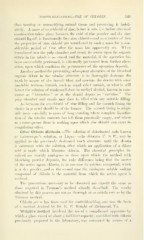Page 551 - My FlipBook
P. 551
TOOTH-BLEACHING— USE OF CHLORIN. 549
thus tanning or mummifying animal tissue and preserving it indefi-
nitely. A mass of oxychlorid of zinc, before it sets, i. e. before chemical
combination takes place between the oxid-of-zinc powder and the zinc
chlorid liquid, is functionally free zinc chlorid—and as a matter of fact
the properties of zinc chlorid are manifested by such a mass for a con-
sideralile period of time after the mass has apparently set. When
introduced into the pulp chamber and canal, its action upon the organic
debris in the tubuli is as stated, and the material, if the operation has
been successfully performed, is effectually prevented from further alter-
ation, upon which condition the permanence of the operation depends.
Another method for preventing subsequent alteration of the bleached
organic debris in the tubular structure is to thoroughly desiccate the
tooth by means of the hot-air blast and saturate the dentin with some
insoluble resinous varnish, such as copal ether varnish, or what is still
better the solution of trinitrocellulose in methyl alcohol, known in com-
merce as " kristaline " or at the dental depots as " cavitine." The
pulp chamber and canals may then be filled with any suitable filling.
As between the oxychlorid of zinc filling and the varnish lining the
choice in general should be of the former. The varnish lining is adapt-
able more especially to cases of long standing where complete liquefac-
tion of the tubular contents has left them practically empty, and where
as a consequence there is nothing upon which zinc chlorid can exert its
coao'ulatino' effect.
other Chlorin Methods.—The solution of chlorinated soda known
as Labarraque's solution, or Liquor sodte chloratje U. S. P., may be
applied to the previously desiccated tooth structure until the dentin
is saturated with the solution, after which an application of a dilute
acid is made which liberates chlorin. The chemical principles in-
volved are exactly analogous to those upon which the method with
bleaching powder depends, the only difference being that the source
of the active agent, chlorin, is in one case its calcium compound, which
is a dry powder, and in the second case the analogous soluble sodium
compound of chlorin is the material from which the active agent is
evolved.
The precautions necessary to be observed are exactly the same as
those required in Truman's method already described. The results
obtained by this process are not as thorough or as satisfactory as by the
Truman method.
Chlorin per se has been used for tooth-bleaching, and was the basis
of a method devised by Dr. E. P. Wright of Richmond, Va.
"Wright's method involved the use of a complicated apparatus by
which a glass vessel of about a half-liter capacity, and filled with chlorin
previously prepared in the laboratory, was connected by means of a


